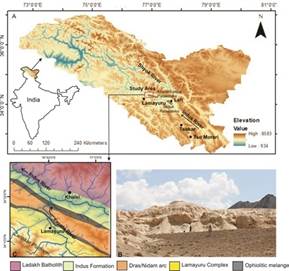30 MAY : Delhi: Secrets hidden in ancient lake sediment deposits recovered from the Indus River valley in Ladakh have helped retrace the climate since last deglaciation from 19.6 to 6.1 thousand years, paving the path towards understanding climate variation during the era.Researchers have reconstructed millennial to centennial-scale climate records from the paleolake deposits and identified a cold arid period, followed by strong monsoon period and subsequent weakening monsoon phase with enhanced El Nino activities with climate variations in the Last Glacial Maxima. Ladakh region in the Trans-Himalaya forms an environmental boundary between North Atlantic and monsoon forcings. Its location is ideal to gain insight into the variations of the atmospheric circulations like westerly and Indian summer monsoon. A comprehensive understanding in the variability of these atmospheric circulations is essential, particularly in the wake of global warming. Besides plethora of sedimentary archives exist in the region that can be used to extract past climate information. Among them, the sediment deposits in lakes, due to their continuous sedimentation rate, are useful in attesting both short and long-term climatic changes. Therefore many studies from the Ladakh region have been attempted from lacustrine sequences to provide information about climate change. However, most of these studies are focused only in the Holocene period (around last 10 thousand years), and older periods are less addressed.
Home Ministry of rural development Records from lake sediments of Indus River Valley in Ladakh help reconstruct...


